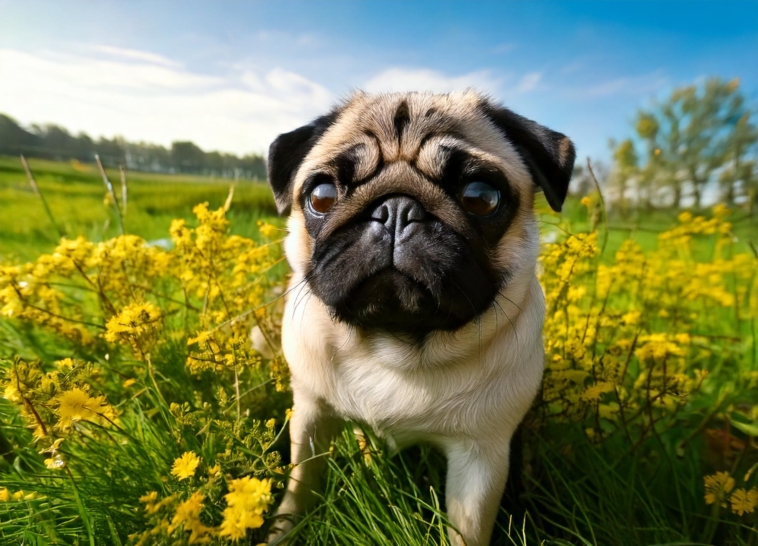Sassy Pugs: Small Dog, Big Attitude
Welcome to the Pug kingdom—a land of wrinkles, waddle-walks, and world-class sass. These little charmers descend from ancient Chinese royalty and still strut around like they own the palace. With their old-man faces and spoiled-toddler personalities, Pugs are in a league all their own.
- Size: Fun-sized, 14–18 pounds of snorty fluff.
- Lifespan: 12–15 years of eye rolls, snuggles, and selective listening.
- Temperament: Equal parts lovebug, goofball, and drama queen.
- Appearance: Round head, smashed muzzle, curly tail—like a cinnamon bun with attitudes.
- Grooming Needs: Constant upkeep because beauty like this doesn’t maintain itself.
They’re social butterflies with diva tendencies. You don’t own a Pug—they allow you to live with them.
Ancient Sass: The Glorious History of Pugs
Pugs trace back—the, uh, scrolls-from-old-Egypt type back.
- China (2000+ years ago): Whelped to heat up emperors’ laps and smug up their faces in the process.
- Buddhist Monks: Devoured them up for their soothing energy and maybe even their goofy snorts.
- Europe (16th Century): Dutch traders brought them west, and voila. Every noblewoman desired one.
- Victorian Period: Full-time lapdogs, occasional fashion accessories.
- Today: Still running the house and snatching snacks like it’s their royal prerogative.
Even after all the centuries of travel, there’s one constant: they’ve always known they’re the protagonist.
The Look: Wrinkled, Round, and Ready for Attention
Pugs have a very distinct vibe: like someone took a bulldog and squished it into a ball with googly eyes.
- Size: Small but solid, like a big chunky paperweight.
- Build: Muscular and unapologetic about it—don’t shame the rolls.
- Head: Round and full of mischief.
- Eyes: Enormous, dark, and always judging you.
- Ears: Floppy little satellite dishes for hearing snack packaging.
- Coat: Smooth, short, and spread all over your couch.
- Tail: Curled like a question mark—usually a question that says, “Where’s the treat?”
- Wrinkles: Deep and dramatic, best for storing crumbs.
The Pug Personality: Sassy with a Side of Sweet
If dogs were television stars, Pugs would be both brooding lead and sitcom sidekick.
- Playful: Infinite energy in five-minute doses.
- Affectionate: Velcro animals that need to be on your lap, bed, and life.
- Stubborn: Will pretend they didn’t hear you until food is spoken.
- Alert: Little watchdogs with big bark opinions.
- Sociable: Adores new people, especially if they have snacks.
They are cute. They know it. And they plan on using it to avoid trouble.
Managing the Sass (Without Losing Your Mind)
Pug training is like negotiating with a very short, furry union representative.
- Start Early: Before they realize they can ignore you.
- Be Consistent: Mixed messages = disaster.
- Socialize Often: The more they’re exposed, the fewer theatrics they’ll put on at the vet’s office.
- Keep It Short: Their attention span is shorter than a sitcom opening.
- Don’t Shout: Speak loudly and they’ll raise an eyebrow—and then sleep.
Positive reinforcement and a good sense of humor are your greatest tools. Also bacon.

Common Pug Health Drama (Because of Course)
Their adorable faces come with. side effects.
- Respiratory Issues: That flat face is a chainsaw sound every time you take a nap.
- Hip Dysplasia: Those teeny little legs sometimes have alignment problems.
- Obesity: They like food more than you (don’t get hurt about it).
- Eye Problems: Their eyes are actually drama balls.
- Wrinkle Infections: Cute creases, but wash them or things go weird.
- Allergies: Grass, food, life in general.
- Dental Issues: Crooked teeth = toothpaste battles.
Vet visits are part of Pug existence. Think of it as pampering your little princess or prince.
Grooming the Sass Factory
It’s work to look this naturally rumpled.
- Brushing: Every other week, or live in a fluff hurricane.
- Baths: Monthly, unless they wade through something mysterious.
- Wrinkle Wipes: Cleanse those creases, but only if you enjoy the smell of regret.
- Nails: Trim every few weeks—tap dancing on tile at 2 AM is not cute.
- Ears: Weekly spa visits to avoid gunk.
Pro tip: Invite grooming as a fun doggy spa day. Bribery is your friend.
Exercise for the Chubby Comedian
Pugs have energy, but in short, chaotic bursts.
- Daily Walks: 20–30 minutes, but don’t expect Olympic pacing.
- Indoor Games: Hide-and-seek, tug-of-war, and “find the squeaky thing.”
- Playdates: Great for socializing and sharing the drama.
- Avoid Overheating: They’re not built for CrossFit.
They’ll act like you’re dragging them on a hike. even if it’s just to the mailbox.
Feeding the Sass Monster
A healthy diet keeps their sass sharp and waistline less jiggly.
- Protein: Zoomie juice.
- Carbs: Re-fueling mid-nap.
- Fats: To keep that ‘coat shiny and Insta-worthy.
Vitamins/Minerals: The makeup artist magic.
Tips:
- Feed twice a day, not “whenever they give you the sad puppy eyes.”
- Hold back on the treats unless you’re looking for a couch potato with attitude.
- Vet-approved diet plans = fewer trips to the vet later
Pug Love: It’s Real and It’s Clingy
Pugs adore more than any other dog—and closer. Always closer.
- Shadowing: You get up to take a pee, they get up to take a pee.
- Snuggling: They won’t snuggle. They must snuggle.
- Joy Machines: Their goofy antics can brighten up the crummiest days.
It’s not a pet—it’s a codependent sitcom relationship.
Conclusion: Embrace the Sass
Owning a Pug means embracing the chaos, the cuddles, and the constant snorting.
- Patience: They’ll test it. Often.
- Training: It’s not optional, it’s survival.
- Engagement: Bored pugs invent trouble.
- Affection: Give it generously. They’ll return it tenfold (plus snorts).
If you’re ready for a dog that’s 50% love, 50% drama, and 100% snuggle-worthy, then a Sassy Pug is waiting to change your life—and take your spot on the couch.




